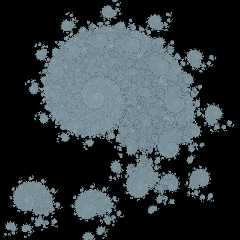|
 |
Last February, Sam Benge introduced a very cool technique and some great images,
created by iterative mapping of images onto discs:
http://news.povray.org/povray.binaries.images/thread/%3C47bf6f44%40news.povray.org%3E/?ttop=275374&toff=100
He also provided the code:
http://news.povray.org/povray.binaries.scene-files/thread/%3C47bfbb8e%40news.povray.org%3E/
This technique can also be used to produce "normal" (Iterated Function System)
fractals, using the condensation set method (repeated shrinking, moving and
pasting), as opposed to the more familiar "chaos-game" bouncing dot method.
Just to make sure I was understanding what was going on, I rendered the same
fractal using Povray and Iterative Imaging (the first picture), and then using
the chaos-game approach, with Apophysis ( http://www.apophysis.org ).
Because the condensation set method involves repeated shrinking, round-off
errors quickly accumulate, unless you render the image very large. I made this
one 3200 x 3200. I've included a close-up of the actual size, also.
Since rendering this, I thought of a way to eliminate the "cut-off" where the
fractal goes off the edge of the box. I now use planes, and just shrink and
map the pigments on the planes. Also, when the fractal overlaps itself, you
need to choose which plane goes on top -- this leads to slightly different
images, even though the actual attractors are the same.
Post a reply to this message
Attachments:
Download 'spiral7_99.jpg' (127 KB)
Preview of image 'spiral7_99.jpg'

|
 |




![]()